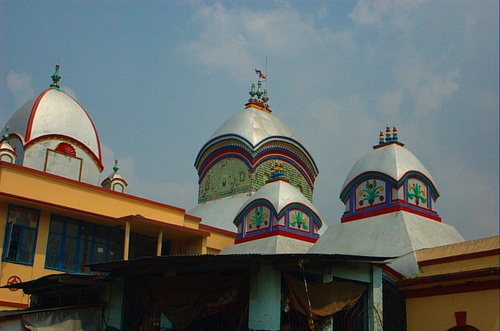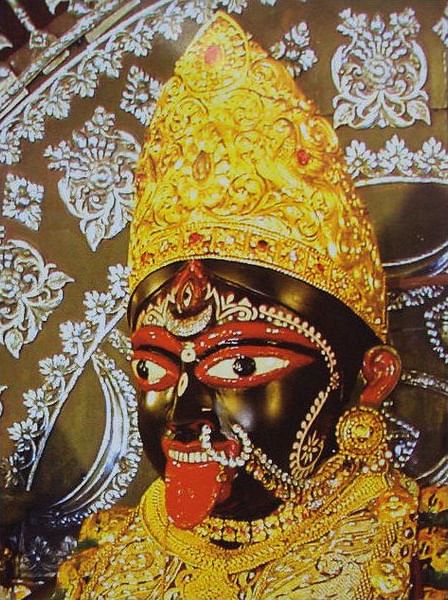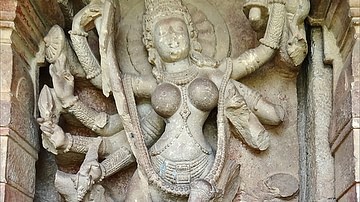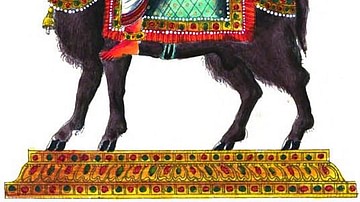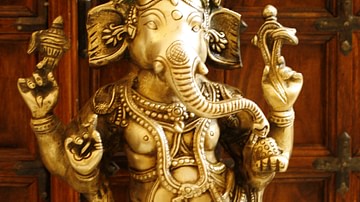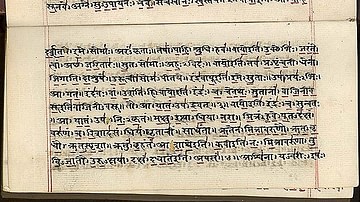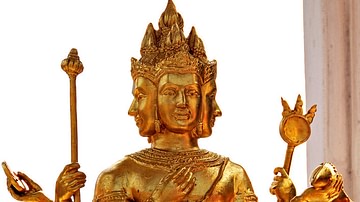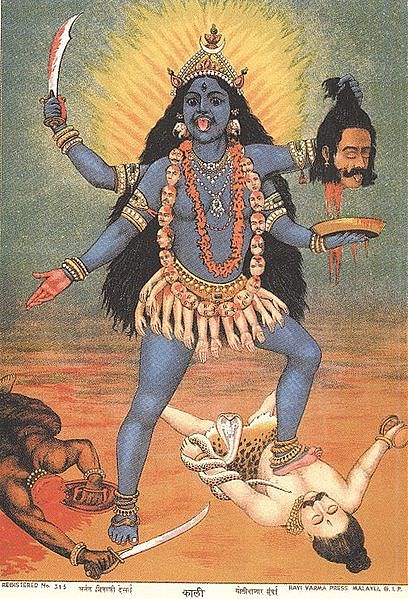
Kali is the Hindu goddess of death, time, and doomsday. She is often associated with sexuality and violence but is also considered a strong mother figure and symbol of motherly love. Kali embodies shakti – feminine energy, creativity and fertility – and is an incarnation of Parvati, wife of the great Hindu god Shiva.
Kali is most often represented in art as a fearful fighting figure with a necklace of heads, skirt of arms, lolling tongue, and brandishing a knife dripping with blood.
Name & Worship
Kali's name derives from the Sanskrit meaning 'she who is black' or 'she who is death', but she is also known as Chaturbhuja Kali, Chinnamastā, or Kaushika. As an embodiment of time Kali devours all things, she is irresistibly attractive to mortals and gods, and can also represent (particularly in later traditions) the benevolence of a mother goddess.
The goddess (devi) is particularly worshipped in eastern and southern India and specifically in Assam, Kerala, Kashmir, Bengal – where she is now worshipped in the yearly festival of Kali Puja held on the night of a new moon – and in the Kalighat Temple in the city of Calcutta.
Kali's Birth
There are several traditions of how Kali came into existence. One version relates when the warrior goddess Durga, who had ten arms each carrying a weapon and who rode a lion or tiger in battle, fought with Mahishasura (or Mahisa), the buffalo demon. Durga became so enraged that her anger burst from her forehead in the form of Kali. Once born, the black goddess went wild and ate all the demons she came across, stringing their heads on a chain which she wore around her neck. It seemed impossible to calm Kali's bloody attacks, which now extended to any wrongdoers, and both people and gods were at a loss what to do. Fortunately, the mighty Shiva stopped Kali's destructive rampage by lying down in her path, and when the goddess realised just who she was standing on, she finally calmed down. From this story is explained Kali's association with battlegrounds and areas where cremation is carried out.
In another version of the goddess' birth, Kali appeared when Parvati shed her dark skin which then became Kali, hence one of her names is Kaushika (the Sheath), whilst Parvati is left as Gauri (the Fair One). This story emphasises Kali's blackness which is symbolic of eternal darkness and which has the potential to both destroy and create.
In a third version, men and gods were being terrorised by Daruka who could only be killed by a woman, and Parvati was asked by the gods to deal with the troublesome demon. She responded by jumping down Shiva's throat. This was because many years previously Shiva had swallowed halahala, the poison which had risen from the churning of the ocean during the creation and which had threatened to pollute the world. By combining with the poison still held in Shiva's throat, Parvati was transformed into Kali. Leaping from Shiva's throat in her new guise, Kali swiftly despatched Daruka and all was well with the world once more.
Kali & Raktabija
Finally, in yet another version of Kali's birth, there is the story of the terrible demon Raktabija (Blood-seed). This demon was, like most demons, causing a great deal of trouble with people and gods alike but even worse was his ability to produce more demons every time a drop of his blood spilt to the ground. Therefore, each time Raktabija was attacked, the only result was more demons to deal with. The gods decided to work together and combine all of their shakti or divine energy and produce one super being that could destroy Raktabija; the result was Kali (in another version only Durga produces Kali). Given all the divine weapons of the gods, Kali swiftly sought out Raktabija and his demons and proceeded to swallow them all whole so as not to spill any more blood in the process. Raktabija himself was killed when Kali lopped off his head with a sword and then drank all of his blood, making sure none fell to the ground and thereby ensuring no more demons could menace the world.
Another famous story involving the fearsome goddess is her escapade with a band of thieves. The thieves wanted to make a human sacrifice to Kali, and unwisely chose a Brahmin monk as a likely victim. Dragging him to the nearest temple, the thieves prepared to make the sacrifice in front of the statue of Kali when suddenly the statue came to life. Outraged at the thieves' plan to kill a monk, the goddess took swift revenge and decapitated the whole gang, even tossing their heads about for fun, whilst naturally the Brahmin escaped to continue his life of scholarly reflection.
Kali In Hindu Art
In art, Kali in her feminine form is most often portrayed with blue or black skin, naked, and wearing a Bengali type crown of clay which is painted or gilded. She is, like many Hindu deities, a multiple-armed figure with the number of arms being four, eight, ten, twelve, or even eighteen. Each arm usually holds an object and these can include a sword, dagger, trident, cup, drum, chakra, lotus bud, whip, noose, bell, and shield. Sometimes her left hand forms the abhaya mudra, whilst the right makes the offering varada mudra. She is often represented seated with legs crossed and having eight feet.
Kali's most common pose in paintings is in her most fearsome guise as the slayer of demons, where she stands or dances with one foot on a collapsed Shiva and holds a severed head. She wears a skirt of severed human arms, a necklace of decapitated heads, and earrings of dead children, and she often has a terrifying expression with a lolling extended tongue which drips blood.
